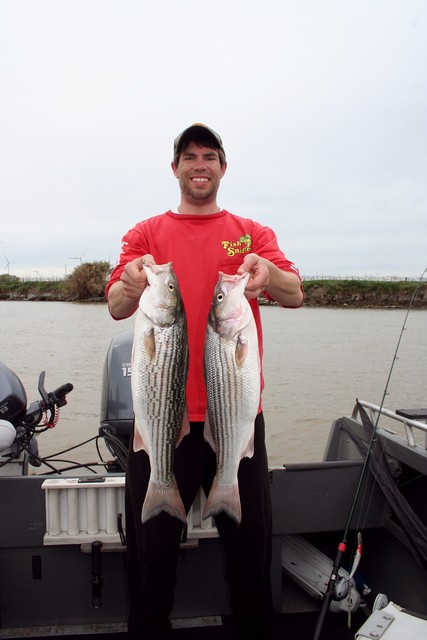Spring fever strikes early when you’re a striper angler. By the end of February, the thoughts start running through your mind. Are they going up river yet? Where are they staging in the delta? Maybe they’re still in the bay. Somebody’s getting them somewhere.
Then, the next phase sets in. The message board checks, Facebook searches, chatting with your neighbor, phone calls, and text messages to fishing buddies begin. “Anybody getting any stripers yet?” You probably have this exact sentence saved in your sent messages. Welcome to springtime!

The spring striper run in Northern California normally spans between March and early June. The exact outcome will depend on weather, water temperatures, dam releases, and any number of other factors. Striped bass typically start staging in the delta in early March. In some years, they migrate up the Sacramento or Feather Rivers to spawn. In other years, the majority of fish stay in the delta to spawn in or near the San Joaquin River between Antioch and Middle River.
Where are they going to show up this year? That’s anybody’s guess, but early indications are that the small males are starting to group up in the San Joaquin River.
On March 19th, I was invited by Jim Brittain on a prospecting trip for spring stripers. Jim is one of the best striper trollers I have ever fished with. Since he doesn’t really fish with bait, the Sacramento River side of the delta was pretty much off limits.
Record rainfall and dam issues have made this year’s water flows much higher than normal. Because of this, the Sacramento River looks like a raging brew of chocolate milk. Although muddy water hinders trolling, I will definitely be out there soon in my own boat soaking some kind of smelly bait like sardines or chicken livers.
For our trolling trip, I met at Jim’s house at five-thirty in the morning. He drove us down the meandering levees of Highway 160 in the pre-dawn shadows to the Brannon Island launching ramp. Since we would be pulling lures, we started out on the San Joaquin River. It typically has much less sediment than over on the Sacramento River, and we had heard some early reports of fish being caught on the San Joaquin.
Jim started us out near the mouth of Three Mile Slough trolling three-quarter ounce Rat-L-Traps off the sides of the boat, and a Yo-Zuri deep diving Crystal Minnow off the back. Jimmy worked the boat aggressively, keeping the speed at about four miles-per-hour.
I was slowly working my rod-tip back and forth when I felt a sharp thud, followed by stabbing pressure on my rod. “There’s one,” I relayed to Jimmy. “It’s a little one,” I said.

The first striper of the day was only about 14 inches long, and I quickly released the fish after securing it with my Boca grip. One bit of advice I always preach to people who are new to the trolling game is this: treble hooks don’t feel good when impaled in your hands.
When dealing with thrashing stripers and lures sporting several sets of large treble hooks, it’s always better to be safe than sorry. Use a fish gripper and needle-nosed pliers to keep those hook points at a safe distance from your hands.
After safely releasing the first fish, we hit a slow period and Jimmy decided to switch to deep diving plugs on all three rods. While making a pass into the incoming tide, my rod went off, and we had our first keeper of the day. It was a typical small male that you tend to catch in the early spring. After catching a few more fish, we pulled lines and shot down to a new area near the Antioch Bridge.
At our new spot, Jim immediately landed another keeper. I followed suit, and soon after we each landed a few more fish to add to our total. The incoming tided waned, and the outgoing tide started flushing water out towards the bay with force.
The outgoing tide typically pushes current faster because it has the momentum of the dam releases behind it. Because of this, it typically stirs up more sediment and vegetation than the incoming tide.
On the outgoing tide, we tried spots further up the San Joaquin River, as well as several locations on the Sacramento River. None of the spots panned out, and the Sacramento River was getting dirtier by the minute. We decided to call it a day at about three o’clock in the afternoon after a long dry spell.
Our trip ended with six keepers and six undersized stripers. We kept three of the fish in the four to five pound range for tacos, while the rest were released.
It was a solid trip – mission accomplished! It seemed like the path to success was to run and gun to lots of spots, while not spending too much time working any single area. We found some small, scattered schools of fish, but none of the larger schools you hope to stumble onto and work for an extended period of time.
By the time you read this, the striped bass will be grouped up thick…somewhere. The only way to find out where is to do some research, and to get your lines wet. You may even see me out in my own boat trolling, or soaking bait somewhere on the mighty Sacramento.
